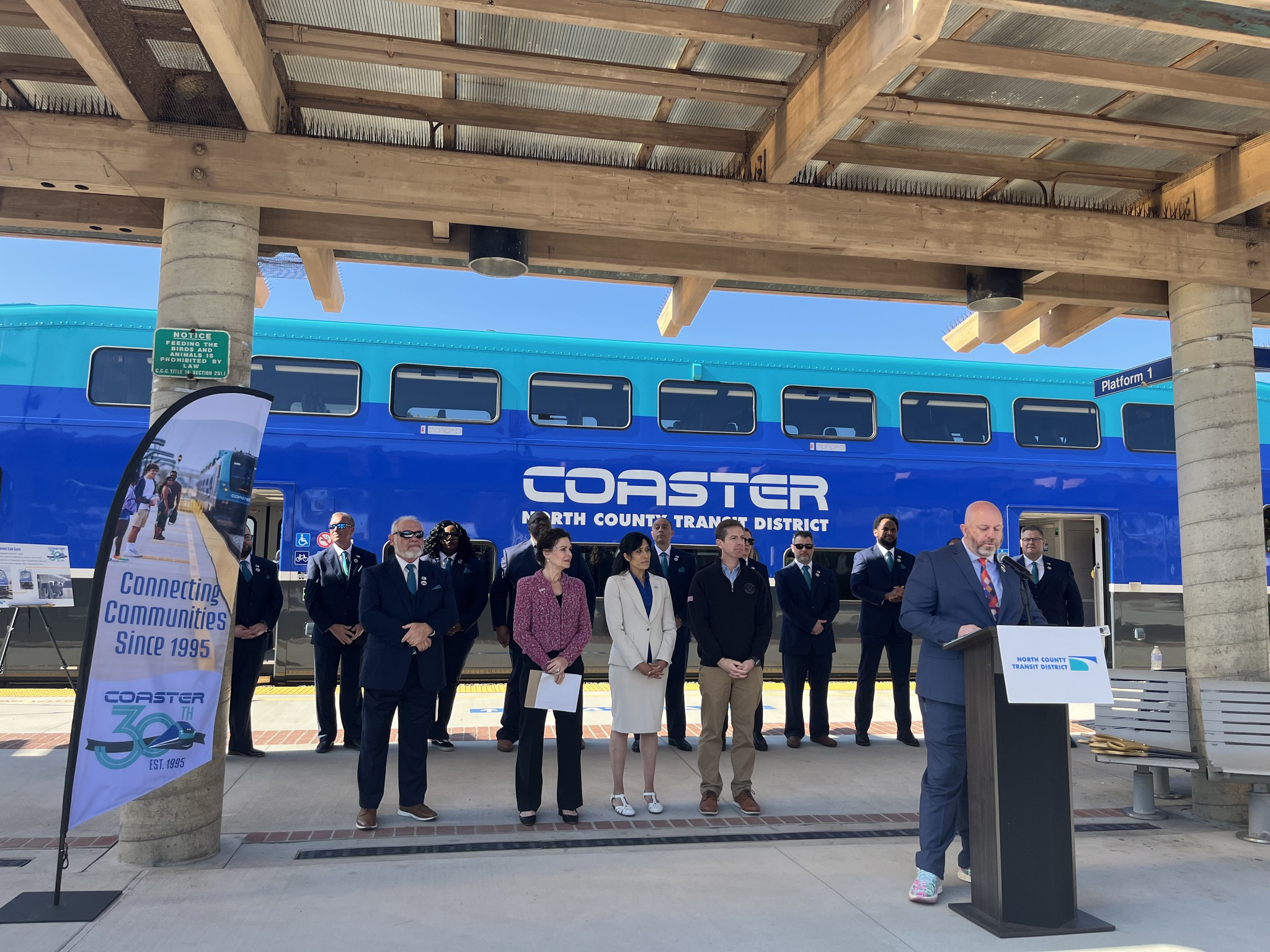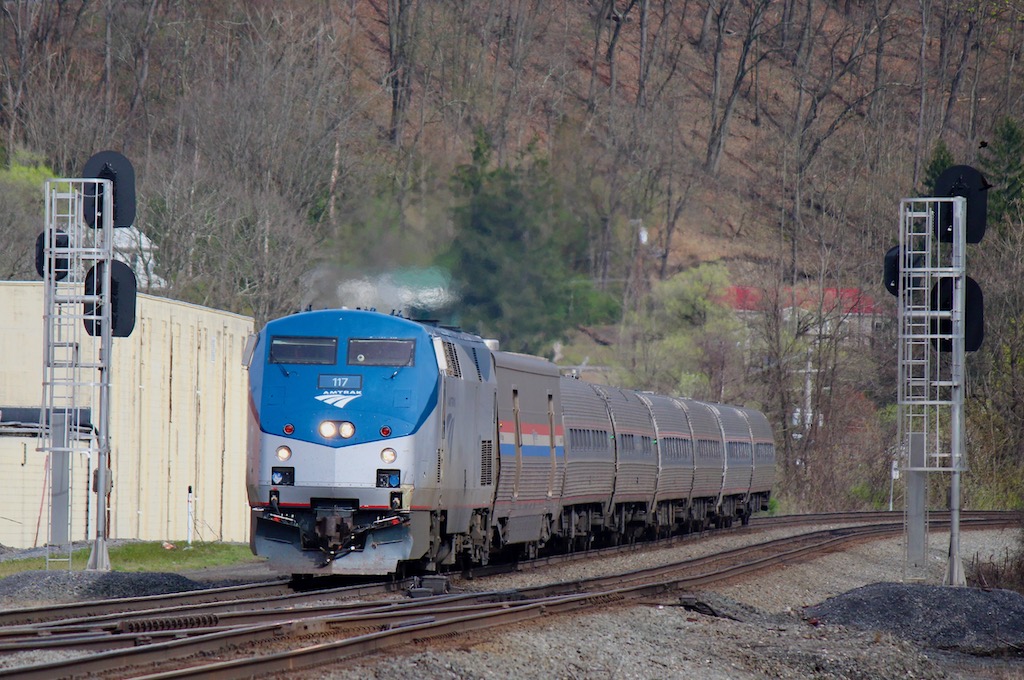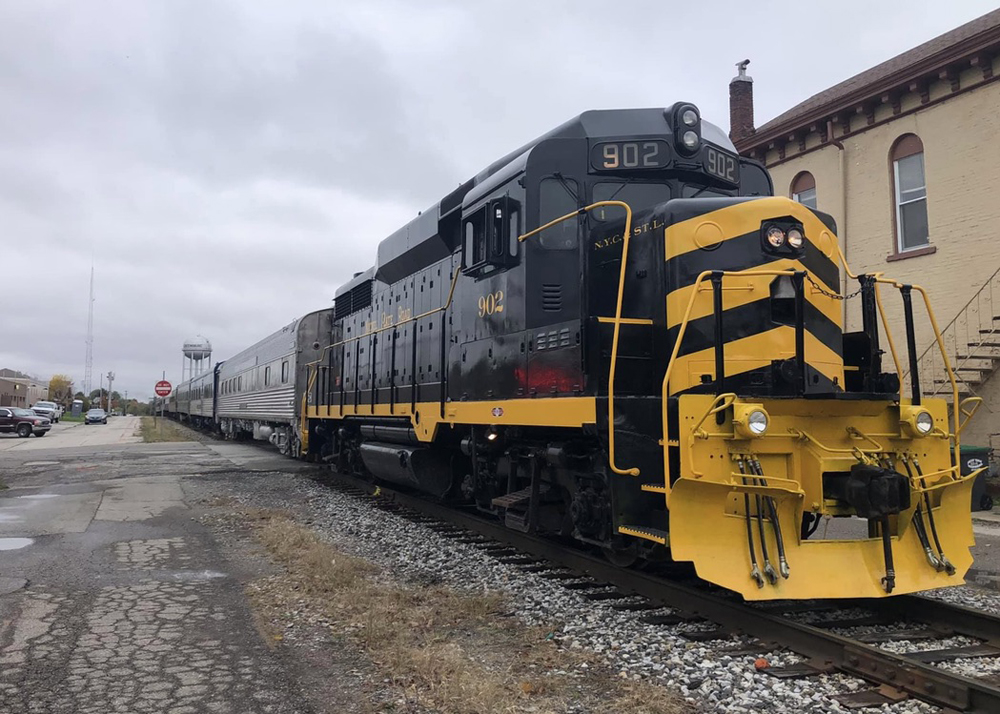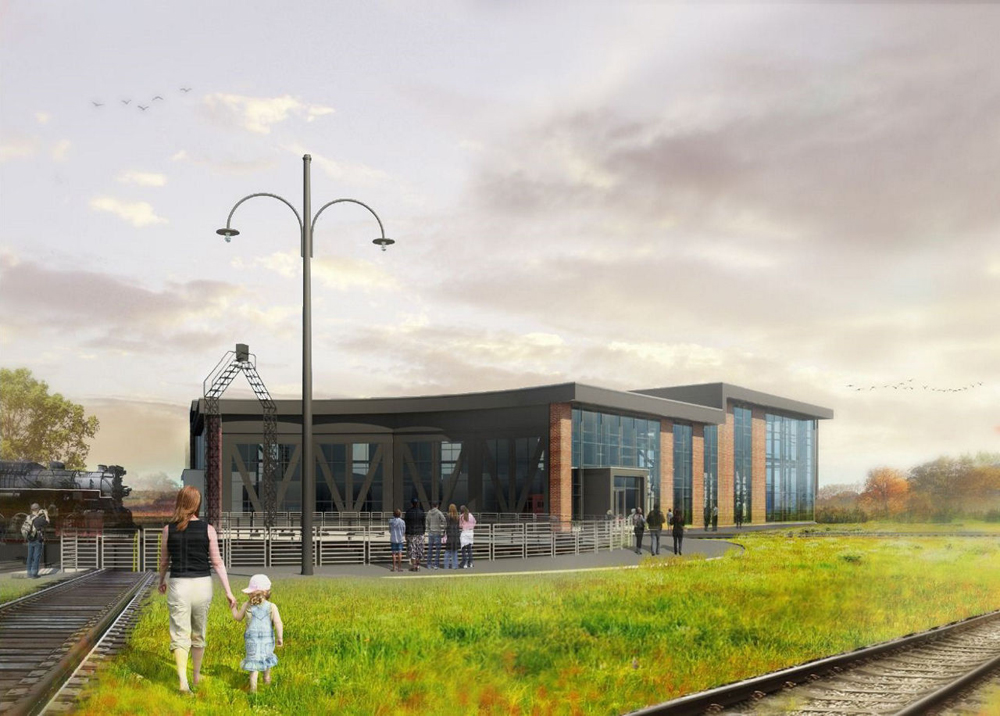CSX has steadily improved on-time performance over the past two years, says Arthur Adams Jr., vice president of sales and customer engagement.
CSX’s trip-plan compliance for intermodal containers and trailers rose to 94% in the third quarter, up from 73% at the end of last year. And merchandise carload trip-plan compliance hit 74% for the quarter, up from 65% at the end of 2018, and is currently running above 80%.
“At the end of the day, this is about reliability,” Adams told the North East Association of Rail Shippers.
Just as important: Making it easier for customers to do business with the railroad. Shippers choose trucks over railroads because the experience, from order to pickup and delivery, is so much simpler, Adams says.
It’s one reason why rail market share has declined to just 8%.
“Other modes are eating our lunch,” Adams says.
“The challenge is what are we going to do about it? I think the key is customer engagement and customer experience,” Adams says.
CSX announced on Oct. 7 that Adams has been named vice president of merchandise sales. He will continue to oversee the railroad’s customer engagement efforts.
This year the railroad has taken several steps to improve the way it interacts with customers. Among them: Making its automated phone system less complex, combining three separate customer service groups into one, building a sales team that can teach customers how to be more successful with rail shipments, and providing more accurate data in the way customers want to see it on its ShipCSX portal.
Next year, CSX will again upgrade its ShipCSX web tools to provide faster and better pricing information as well as more visibility into the trip plans for individual carloads and intermodal shipments.
Ultimately, online tools will provide visibility on interchange with connecting shortlines and Class I’s, Adams says. But that’s still a few years off.
CSX has created two receiver analyst positions to educate receivers on ShipCSX online tools and to help identify and resolve customer concerns.
Receivers don’t pay for freight, Adams notes, but they are an integral part of the supply chain. They’re also an untapped growth opportunity because railroads typically deal with shippers, not receivers. Already CSX has found plants that received rail shipments, but sent everything out by truck and are now candidates for conversion to rail.
“What a great opportunity to convert business — business that in many cases should be moving by rail but it’s not because we failed to engage,” Adams says.
“There’s tremendous upside here,” Adams says.
In response to a question about whether the customer focus of the sales team has made its way to other departments at the railroad, Adams said the level of optimism and collaboration has improved under the railroad’s shift to Precision Scheduled Railroading.
Every morning, for example, senior operations and sales people meet for an hour to resolve ballast-level service issues.
If local Y173 didn’t run yesterday, and the customer is scheduled for switching five days per week, what’s the recovery plan?
“That level of detail is where we are at,” Adams says, adding that improving first- and last-mile service is critical to regaining merchandise carload traffic.















He’s right they can regain market share from trucks but do they want to and will they? They normally pick the low hanging fruit and leave the rest to rot. An extra car or two on a train might raise their operating ratio and disappoint their Wall Street overlords.
It’s disheartening when an exec makes statements that demonstrate a lack of understanding ofmthe capabilities and limitations of his own company.
Fact is, CSX’s plant, equipment and operating personnel have all been so truncated that the market he thinks exists simply cannot be addressed.
Knowing that it has been done–and profitably–in the past makes it no more or less painful in light of the reality now extant. The program of disinvestment that has gone on for years–but particularly in the past several years under PSR–iis yielding its toxic fruit.
I would encourage all of you who are interested in transportation’s role in the economy to read the WSJ article “The key to the Long Expansion? Logistics”, in the July 8 issue of the paper. From our perch in railroading, we have an understanding of a vital element of the logistics chain mst people don’t understand or appreciate. The key finding of the WSJ article was that the economic cycle of expansion and contraction–boom and bust–has been tamed by logistics and timely knowledge of market demands enabled by computerization. But where logistics fails, or is inefficient, market distortions will develop. That’s why a market-oriented rail system is so important to national well-being.
Declaring “profits” on the back of deferred maintainance of plant and equipment is destructive folly.The practice of shoving rolling stock that was designed to be pulled may well produce maintainance issues that aren’t provided for or properly cost-allocated. Skimping on dispatch personnel seems to have had the effect of increasing derailments. Why there should be any in the era of GPS is a mystery to me if someone is minding the store. Instead of lowering OR, I would think deploying a cost-realistic electronic braking device should be a high priority. Oner would think the cost savings from equipment wear and tear and derailments would be self-liquidating. Sure would be a boon to operators in high profile districts, especially those with heavy trains.
m
Will never happen until they get rid of PSR and make the customers more important than the CEO and sharholders
Amazon trucks, UPS trucks
I wish Mr. Adams success in finding his next job as what he is advocating flies directly in the face of unit train PSR mentality. That ‘one car at a time’ or maybe 2 for a customer would surely impede the 150+ unit trains, and inhibit share value due to that dreaded O/R creep.
A former boss told me that the first sale to a customer is easy, it is the second one that can be tough; and from the various comments here and elsewhere that is message the Class 1’s still aren’t geting.
@Anna Harding: Railex could beat the trucks from California to Jacksonville under 2 conditions. 1. There had to be enough reefers in the consist going east to make it worth CSX while. 2. Route the reefers from UP to CSX via St Louis and over the Illinois Sub to Vincennes and then south to reach Jacksonville.
CSX held the sub open for awhile and even expanded the Hopkinsville Yard in Kentucky to support the crew changes. While I have no proof of it, many thought Railex was going to get enough produce to Jacksonville to support a reefer unit train where a UP engine set would take it as far as Hopkinsville Yard, where they would turn around and take Jacksonville sourced reefers of pineapples and any empties back to California.
UP already used the sub as a way to bypass Illmo and get Chicago based freights on their line at Salem, Illinois so they were already familiar with the line.
But because Railex could not get the produce volumes due to the drought, it wasn’t worth it for UP or CSX to allow such a small reefer set to get express service. So what reefers Railex could get, were aggregated at Green River Wyoming, expressed to Chicago and then tagged on the back of one of CSX CHI to JAX trains.
That extra yard time in Chicago and then CSX having to carry it several hundreds of miles farther to reach Jacksonville, put them at a disadvantage with truckers. They could carry the smaller drought stricken loads and drive straight to Jacksonville and beat Railex.
CSX finally cut the rails on the Illinois Sub.
Railex threw in the towel in 2017.
UP bought the reefers from them.
https://www.up.com/media/releases/170103-railex.htm
Anna, prior to retirement, I was a locomotive engineer on CSX’s Chicago-Willard line. The Railex service, when it began, was operated with 70′ cushion draft gear reefers. The early, dedicated reefer trains were in the 20-30 car neighborhood. They grew become 70-90 car trains which were more of a challenge to handle properly. The hydraulic drawbar mount made for 60″ of cushion slack per reefer. This resulted in more than a few broken knuckles because of the emphasis on the use of dynamic braking for speed control. An 80 car Railex train (we nicknamed them Salad Shooters) would have 400 feet of slack. They were permitted to operate at Class 4 speeds.
I’ve noticed that the Railex service often now operates in regular, non-dedicated, mixed freight trains.
Easier said than done – Railroads just do not have the people who understand how important SERVICE is to the individual small customer The day has come that they are trying to regain their arrogant past. I watched as the railroads thru their arrogance gave it away to the more acceptable truckers service.
GOOD LUCK !
Something else just occurred to me, and is a fundamental difference between the origins of railroads in the Old World and railroads in the New World.
In the Old World, railroads were installed primarily as transportation systems serving established population. London and Liverpool, Munich and Berlin, Paris and Strassburg, all were there when the railroads were installed. Thus, even if the railroads were did not directly pay for themselves, there was a social net worth in ensuring (within limits, see the Beeching Axe) that they stayed in operation, even at government expense.
In the New World, while railroads in the East started out as transportation systems serving, say, Philadelphia and New York, the real money was in the west, and was not in transportation. The real money was in land, cheap and unusable before the arrival of the railroad, worth a great deal with the provision of ready access afforded by the railroad. This is evidenced by some of the machinations of the builders of the First Transcontinental Railroad, who engineered a land grant system giving them huge swatches of land, followed by route planning which can only be described as circuitous, and with the purpose of obtaining as much of these land grants as possible.
It therefore follows that the railroads were not primarily there to provide transportation, but that they were there to make money off selling, leasing, or otherwise exploiting the land they acquired as a condition of building the transportation system. It also follows that the actual railroad was in the nature of a “loss leader”, intended to run on a break-even or lose-a-little basis, all to be written off as the cost of doing business.
In 2019, most or all of these lands have been disposed of, and now the railroads are expected to pay for themselves. Having never been designed to do so in the first place, it could well be they simply cannot do so.
In which case, yes, we are barking up the wrong tree, and yes, they are irrelevant to the 21st Century.
Does anyone feel like kicking this thesis around for a bit to see how it yelps?
The above comments are generic in nature and do not form the basis for an attorney/client relationship. They do not constitute legal advice. I am not your attorney. Find your own bleeping lawyer.
“building a sales team that can teach customers how to be more successful with rail shipment”
Maybe, instead, they should teach railroad employees how to meet customers needs and expectations. They’ve got it backwards.
Mister Rice:
So what you are telling me is that had they been able to get the produce the scheme might have worked. But the drought was nasty (I remember five dollar heads of iceberg lettuce, say hello to romaine), and what with global warming we can expect things to only get worse.
In what way was trucking beating Railex? Was it because they could do it cheaper, because they could do it faster (remember, if there is anything time sensitive it is perishable goods), because they were more flexible? In the post-mortem, details are important.
The rump service which still exists. How has it remained viable? What advantages does this service offer over trucking?
Here is something to remember. With foodstuffs you gotta maintain the cold chain. On trucks, that is done by equipping the trailer (if it is a van) with a diesel driven compression type refrigeration system, with containers it is frequently done with plug-in. How was it done by Railex? Or did they use traditional reefer cars?
Something else. What sort of priority did these Lettuce Specials get from the railroads? Were the cars equipped with high-speed trucks? Were they allowed to move at Class 4 track speeds? What provisions were made for quick loading and unloading?
And does anyone have an analysis as to what the volume would have had to be for the service to be competitive against trucks?
The above comments are generic in nature and do not form the basis for an attorney/client relationship. They do not constitute legal advice. I am not your attorney. In an alternate reality I might be your attorney, but in this reality I am not so get your own bleeping lawyer.
Mister Rice:
It could be that all they want is the high-volume low-handling point-to-point unit traffic. If this is the case, would they kindly have the honesty to say so, and stop wasting our time. And if it is the case, how can they then justify their status (and the consequent legal privileges) as common carriers? It is too much to ask for a little bit of truth in advertising here?
On a related topic, way back when there was Fruit Growers’ Express which ran produce all over the place, and did so swiftly. A few years ago, if memory serves correctly, a revival of a similar service, between the Pacific Northwest and the greater New York area was attempted. Does any one have any information as to what happened to this service? Is it still running? Was it able to pay for itself?
The above comments are generic in nature and do not form the basis for an attorney/client relationship. They do not constitute legal advice. I am not your attorney. Find your own bleeping lawyer.
@Anna Harding: Railex used to run an express perishable business using UP and CSX. But the extended California drought through 2015 pretty much ruined it.
UP would aggregate Cali produce with Washington apples at Green River Wyoming, and then express it to CSX outside Chicago, where they would take it to Rotterdam NY.
If it wasnt for the drought, Railex was going to set up a produce service triangle with Rotterdam NY, Jacksonville Florida as the east coast endpoints.
Jacksonville was going to be the transload of fresh pineapples to go north and west. Cali wines, radish, onions and asparagus was coming east along with Washington apples, pears and cherries. Jacksonville would transload the west coast produce for express export. Rotterdam would provide imported euro cheeses, and perishables from the old country.
Railex had planned up to 50 reefers for each leg from the west,the Rotterdam set via CSX in Chicago and the Jacksonville set via CSX at East St Louis.
It all fell apart because Railex couldn’t get enough produce to fill that many reefers. So UP took everything through Chicago, where CSX would break the consist and send some to Jacksonville and some to Rotterdam.
That routing to Jacksonville via Chicago was uneconomic as truckers could then beat the service levels that Railex has promised.
After their demise, UP invested in a set of reefers and instituted something similar to the old FGE.
UP/CSX still support the Rotterdam express route.
CSX truncated their perishable service into a triangle of Jacksonville, Rotterdam and Chicago using the Newport Indiana logistics facility near South Bend.
Anna Harding, interesting analysis. I don’t have anything to add, but I’m interested to see it discussed by thoughtful and knowledgeable people.
CSX has NO credibility when it comes to customer service thanks to Harrison. It sucks!
What if I want a CSX container service from Asia in Michigan? A service you have already factored out and told us to dray it out of Chicago? Are you going to retreat and actually deliver me 100 containers a week? Or do I call BNSF or CN?
As I have said before, if you “factor out” the hard work customers and only seek those who will work with your severely low standards, then your success and therefore bonus will be guaranteed.
I wish you luck!
I have watched csx turn away business constantly simply because manage doesn’t want the paperwork or extra crews. Even when another local goes past the industry it is so cost prohibitive and difficult to get rail service started its a wonder any business tries at all.
Unless CSX and the other PSR Kool-Aid drinking executives can provide truck-competitive transit times (i.e., at passenger train speeds with multiple daily frequency departures, in short 1000 meter train lengths) they are NEVER going to remove trucks from the highways.
This is all smoke and mirrors from Mr. Adams.
Rather wishful thinking from a shrink-mode bunch of share price pumping, pocket-stuffing executives.
Well good for and God bless ‘im! Fortune favors the bold, and the optimists. No-one ever accomplished anything who just sat around saying “It can’t be done.”
I suspect the real challenge will be getting the rest of the CSX organization to play ball with him.
I wish CSX and Mr. Adams all the luck. Rail has a big advantage on fuel and labor costs so I hope they can improve their market share.
What would be the biggest boon to railroads for carload traffic is if someone was willing to start a company that combines the Warehouse size flooring of COSTCO/Sam’s Club, with the distribution savvy of Amazon. Let me explain simply, you buy and/or build/lease an extremely(and I do mean extremely, Distribution Center size) facility and set it up like an IKEA. Inbound product is delivered by the carload and purchased directly from the manufacturers(this works mostly for consumer goods and non-perishable foods), have the carloads delivered to each individual warehouse/store based on locality ordering(you don’t sell all the exact same products across the U.S., WalMart learned that decades ago). The warehouse/store sells directly to the consumer, cutting out both brokers and intermediate storage facilities. Would it cost billions to start up…yes, would it be the next step in retail…I believe so. Would it bring large volumes of traffic from the highways back to rail…it could, if there was a willingness to also spend on infrastructure to facilitate such a business.
94% on time for intermodal is stellar, 74% for merch is pretty great but that too needs to increase. Both numbers are well above industry baseline which is somewhere around 75/55 historically.
One can also see how the complexities of merchandise traffic make it structurally more challenging to deliver a consistent product. Still too many handlings, too many variables, and too susceptible to the weather.
JOE – Thank you sincerely. All is good! Maybe I learned something from your earlier criticism of my posts!
One major problem may be that many customers who receive shipments by rail no longer are set up to ship out by rail. One large paper mill here in the Mobile, AL area once shipped huge amounts of paper by rail. Now though some pulp and chemicals are delivered by rail, the spurs into their paper warehouses have been torn out and the docks paved over. All finished product leaves in trucks. The cost of putting the infrastructure back would I suspect be cost prohibitive unless rails shipment got a lot more reliable. And that’s just one of many industries in this area alone that no longer can ship by rail because the spurs were torn out. Although I’d like to see things turn around for railroads as far as their losses to trucks, I think they sealed their long term fate back in the late eighties when they decided that intermodal was they only thing they wanted.
Words alone have no value and cannot be substituted for deeds. CSX needs to focus on DELIVERING service not just boosting management salaries & the stock price.